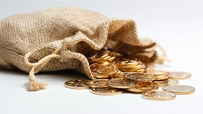How Jewellers in India Calculate Gold Price
June 26, 2025

Gold jewellery holds a special place in Indian culture, often bought during festivals and family celebrations. In recent times, gold prices have soared – for instance, 24-karat gold crossed ₹75,000 per 10 grams in India. With such high prices, it's crucial for you to know how jewellers determine the price of gold jewellery before you make a purchase.
Jewellers don’t just weigh the gold and quote a price; they use a standard formula and consider multiple factors to arrive at the final amount you pay. In this comprehensive guide, we break down the pricing formula, explain the key factors, and share tips to ensure you get fair value for your gold jewellery.
The Jewellers’ Pricing Formula (and an Example)
Jewellers in India generally follow a standard formula to calculate the final price of a gold jewellery piece. In simple terms, the formula is:
Final Jewellery Price = (Gold Rate per gram * Weight of gold in the piece) + Making Charges + 3% GST + Hallmarking Charge.
If the piece has diamonds or other stones, their cost would be added as well before applying GST. Note that if making charges are quoted "per gram," you multiply that by the weight and add to the total; if it's a percentage, you calculate that percentage of the gold value.
Let’s break down a quick example to illustrate this calculation:
Now, step by step calculation:
So, the jeweller would quote ₹79,355 (inclusive of all charges) for this 22K, 11-gram gold chain in this scenario. If your jewellery also had a diamond, you would add the price of the diamond (say ₹4,500) to the subtotal before calculating GST. Each item’s gold content is calculated separately if you have pieces of different purity (e.g., a 22K chain and an 18K ring will be priced on their own and then summed up).
The key takeaway is that the sticker price on a gold ornament is not arbitrary; it comes from a clear formula. As a buyer, you can ask the jeweller to show you the calculation. Verify the gold rate they used (it should match the day’s prevailing rate for that purity) and check the making charge percentage or per gram rate applied.
Why Gold Jewellery Prices Differ Among Jewellers?
If you've ever compared gold prices at different shops or in different cities, you might have noticed slight variations. Gold prices are not uniform across India – they vary city to city because each city’s bullion association sets a daily gold rate every morning. Jewellers in your city adhere to the local association's rate, which may differ from the rate in another city. Fortunately, these differences are usually minor since other factors (like making charges, purity, and taxes) have a bigger impact on the final price.
Prices can also differ from one jeweller to another in the same city. According to industry experts, this happens due to different sourcing and overhead costs. For example, a jeweller’s cost of acquiring gold can vary (including refining or transportation expenses), which affects their pricing.
Jewellery purity also matters – some might use slightly higher or lower purity gold, influencing price. Moreover, jewellers add a “making charge” for workmanship, which each jeweller sets independently. Making charges typically range from 10% to 25% of the gold value for the piece. A jeweller with intricate designs or brand prestige might charge on the higher end of that range, whereas a local artisan might charge less. All these variables explain why the same 10-gram gold chain might cost a bit more at Jeweller A than at Jeweller B.
Key Factors Affecting Gold Jewellery Price
Several components go into the pricing of gold ornaments. Understanding these factors will help you verify quotes and avoid overpaying. Here are the main elements that influence gold jewellery prices in India:
1. Gold Purity (Karatage)
Gold jewellery comes in different purities, commonly 24K, 22K, 18K, or 14K. A higher karat means a higher percentage of gold content, which makes it more expensive. For instance, 24K (99.9% pure) gold costs more than 22K (91.6% pure). Jewellers will price the item based on its purity – you pay only for the actual gold content in the piece.
2. Weight of Gold
This one is straightforward – the heavier the piece, the more gold it contains, and the higher the base price. Gold is priced per gram. If a necklace weighs 10 grams and the per-gram rate is ₹6,500 (for 22K gold), the base gold cost is ₹65,000 in that example. Weight is measured after subtracting any weights of stones (good jewellers will weigh stones separately; more on that later).
3. Daily Gold Rate
The market rate of gold per gram is the foundation of the price. This rate is influenced by international gold prices, currency exchange rates, and local demand-supply. In practice, jewellers use the rate set by the local Gold Jewellers’ Association each day. So if today’s 22K gold rate in your city is ₹5,500/gram, that’s the figure they start with to calculate jewellery cost. (Rates may differ slightly by city or jeweller, but again these are small variances.)
4. Making Charges (Wastage Charges)
Making charges are the labour and craftsmanship fee for turning raw gold into a beautiful ornament. This can be charged in two ways: as a percentage of the gold value or a flat rate per gram.
Intricate designs or brand-name jewellery often have higher making charges because of the skilled work involved. Making charges can significantly bump up the cost beyond the raw gold value – it’s not uncommon for making/wastage charges to add 10–20% to the price.
5. Additional Gemstones or Materials
If the jewellery includes diamonds, emeralds, or other precious stones, their cost is added separately to the gold price. You are charged for gemstones based on their individual price (usually per carat for diamonds, etc.), plus any setting charges. For instance, if a gold ring has a diamond, the invoice will add the price of that diamond on top of the gold cost. Always ensure the jeweller weighs stones separately from gold so you’re not unknowingly paying the gold rate for a stone's weight.
6. Taxes (GST)
In India, a 3% Goods and Services Tax (GST) is applied on the total value of the jewellery (gold + making charges + any stones). This tax is added at the final stage of billing. It’s a standard rate and applies uniformly whether you buy from a big brand store or a small shop.
7. Hallmarking Charges
Jewellers may add a small Hallmarking charge (certification fee), typically a nominal amount (often around ₹35–₹50 per piece). Hallmarking is the official confirmation of the gold’s purity by BIS (Bureau of Indian Standards). Since June 16, 2021, selling hallmarked gold jewellery is mandatory in India, and each hallmarked piece now carries a unique HUID code. The charge for this certification is usually added to the bill (and sometimes it’s already factored into making charges). In our price formula (next section), hallmarking fee is a component to account for, albeit a small one.
8. Design Complexity and Brand Premium
This is a more subjective factor. A renowned jewellery brand might charge a premium simply for their name and service quality (overheads, ambiance, warranty, etc.). Likewise, a very intricate or exclusive design might cost more because you’re paying for the jeweller’s artistry and time. While not a line-item in the formula, this influences where within the typical range the making charges or margins will lie.
Essentially, you might notice established brands quote higher prices than local shops for similar plain gold pieces – often due to higher overheads or profit margins.
9. Negotiation and Discounts
Unlike the gold rate or tax (which are fixed), making charges can sometimes be negotiated. Jewellers may offer discounts on making charges, especially during festive seasons or if you’re buying a large piece. Some stores have fixed prices, but others might be open to giving you a better deal – it never hurts to ask! Also, keep an eye out for promotional discounts or waivers of certain fees. The final price may be influenced by your negotiation skills or ongoing offers.
Tips to Keep in Mind When Buying Gold Jewellery
Buying gold is both an emotional and financial investment. Beyond knowing the calculation, here are some practical tips to ensure a fair deal:
1. Insist on Separate Weights
If you’re buying jewellery studded with diamonds or gemstones, make sure the gold is weighed separately from the stones. Unethical practices include weighing the entire piece and charging gold price for everything. This matters later if you resell or exchange – you’ll only get value for the gold weight, not the stones (unless they are high-quality diamonds). So, the bill should clearly mention the weight of gold and the weight/value of stones independently.
2. Check the Bill Details
A proper invoice is your proof of purity and cost. As per BIS guidelines, the bill should list the description of the item, the net weight of gold, the gold’s purity (karat or fineness), the making charges, and any hallmarking charge. If there are gemstones, their price should be listed separately on the bill. Don’t accept a vague bill – it should itemize each component of the price.
3. Look for BIS Hallmark and HUID
Hallmarking is mandatory in India to ensure you’re getting real purity. When you buy, inspect the jewellery for the BIS hallmark stamp. Since July 2021, hallmarked jewellery includes a BIS logo, the purity mark (like 22K916 for 22K gold), and a unique alphanumeric HUID code. From April 1, 2023 onward, jewellers cannot sell non-hallmarked gold jewellery. So, avoid any jeweller who hesitates on hallmarking – it’s your guarantee of purity.
Final Thoughts
Gold jewellery will always be cherished in India – it’s a symbol of wealth, auspiciousness, and sentimental value passed through generations. However, buying gold wisely means looking beyond the glitter to understand the pricing math. The price you pay for a gold necklace or bangle isn’t just about that day’s gold rate; it’s a combination of purity, craftsmanship, and a few extra charges like taxes and hallmarking. By being informed about how jewellers calculate gold prices, you can confidently evaluate quotes and even save money by choosing jewellers with fair pricing. Remember, an informed buyer is an empowered buyer.
Get Gold Loans up to ₹25 lakh at attractive interest rates with Ujjivan Small Finance Bank. Enjoy quick disbursal and a stress-free loan journey. Apply now!
Disclaimer:
The contents herein are only for informational purposes and generic in nature. The content does not amount to an offer, invitation or solicitation of any kind to buy or sell, and are not intended to create any legal rights or obligations. This information is subject to updation, completion, amendment and verification without notice. The contents herein are also subject to other product-specific terms and conditions, as well as any applicable third-party terms and conditions, for which Ujjivan Small Finance Bank assumes no responsibility or liability.
Nothing contained herein is intended to constitute financial, investment, legal, tax, or any other professional advice or opinion. Please obtain professional advice before making investment or any other decisions. Any investment decisions that may be made by the you shall be at your own sole discretion, independent analysis and evaluation of the risks involved. The use of any information set out in this document is entirely at the user’s own risk. Ujjivan Small Finance Bank Limited makes no representation or warranty, express or implied, as to the accuracy and completeness for any information herein. The Bank disclaims any and all liability for any loss or damage (direct, indirect, consequential, or otherwise) incurred by you due to use of or due to investment, product application decisions made by you on the basis of the contents herein. While the information is prepared in good faith from sources deemed reliable (including public sources), the Bank disclaims any liability with respect to accuracy of information or any error or omission or any loss or damage incurred by anyone in reliance on the contents herein, in any manner whatsoever.
To know more about Ujjivan Small Finance Bank Products Visit:"https://www.ujjivansfb.in"
All intellectual property rights, including copyrights, trademarks, and other proprietary rights, pertaining to the content and materials displayed herein, belong
to Ujjivan Small Finance Bank Limited or its licensors. Unauthorised use or misuse of any intellectual property, or other content displayed herein is strictly prohibited and the same is not intended for distribution to, or use by, any person in any jurisdiction where such distribution or use would (by reason of that person’s nationality, residence or otherwise) be contrary to law or registration or would subject Ujjivan Small Finance Bank Limited or its affiliates to any licensing or registration requirements.
FAQs
1. Why do gold jewellery prices differ from one jeweller to another (or city to city)?
Gold prices may vary slightly by city because local jewellers’ associations in each city set daily gold rates every morning. Additionally, individual jewellers have different costs for sourcing gold (refining, transport, etc.) and apply different making charge rates. These factors – plus variations in gold purity used – mean the final price can differ among jewellers even on the same day.
2. What are making charges, and can I avoid or reduce them?
Making charges (sometimes called wastage charges) are the fees for the craftsmanship and labour to create a jewellery piece. They can be a percentage of the gold value or a fixed rate per gram. You cannot avoid them, as every jeweller will charge for their work, but you can compare and negotiate. Some jewellers have lower making charge rates, and during sales or festivals, making charges might be discounted. It pays to shop around if making charges seem high.
3. Do I have to pay GST on gold jewellery?
Yes. Gold jewellery in India carries a 3% GST on the total price (including gold, making charges, and any gemstones). This is a government tax and is the same everywhere – a mandatory addition to your bill. The jeweller will calculate this 3% on the subtotal of gold + making (and stones if any). There’s no way to waive GST, so ensure it’s properly listed on the invoice you receive.
4. Are diamonds and gemstones counted in the gold price?
No, diamonds and other gemstones are priced separately from the gold. When you buy a piece with stones, the jeweller should weigh the gold alone and calculate its price, then add the price of each gemstone on top.
Latest Blogs

Dussehra 2025: How to Win Your Financial Battles with Smart Saving
Dussehra 2025 (also known as Vijayadashami) falls on Thursday, October 2, 2025.

eSIM Scam in India: I4C Warns Mobile Users About Rising Fraud – How to Stay Safe
The Indian Cybercrime Coordination Centre (I4C), a wing of the Ministry of Home Affairs, issued a strong warning to mobile users about the rapid increase in eSIM fraud in India.

How to Link PAN with Aadhaar: Step-by-Step Guide & Consequences of Not Linking
Linking your Permanent Account Number (PAN) with your Aadhaar is no longer just a best practice.

Annual Information Statement (AIS): A Complete Guide for Stress-Free ITR Filing
India’s tax season is in its final stretch.

ITR-1 (Sahaj) Restrictions: Income Sources Not Allowed & Filing Rules
With just a few days left before the 15 September 2025 deadline for filing Income Tax Returns (ITRs) for Assessment Year (AY) 2025-26, many taxpayers are rushing to submit their forms online.





